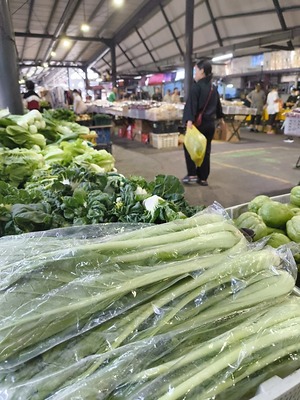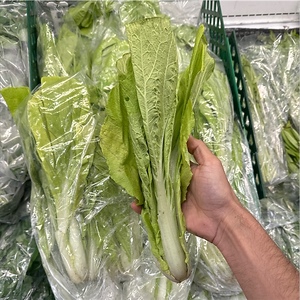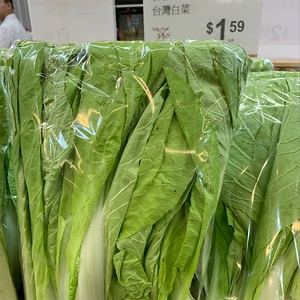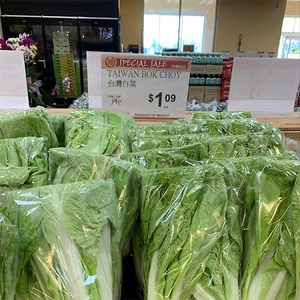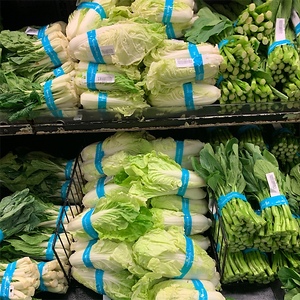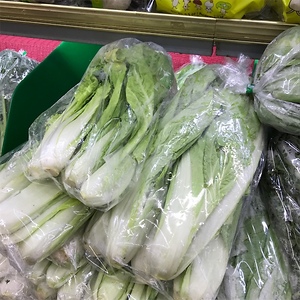


Taiwanese Bok Choy
Estimated Inventory, lb : 0
Description/Taste
Taiwanese Bok choy has long, slender stems, averaging 20-22 centimeters in length, that are connected to large, oval-shaped leaves. Compared to the common bok choy most consumers are familiar with in the market, Taiwanese Bok choy is leafier, and its petioles or stems are elongated, smooth, thin, flat, and white. The slightly crinkled leaves range in color from pale green to green-yellow and are pliable and crisp with prominent veins spanning across the surface. Taiwanese Bok choy is tender and succulent with an earthy, subtly sweet taste mixed with a hint of bitter, mustard-like flavors.
Seasons/Availability
Taiwanese Bok choy is available year-round, with a peak season in the fall through early spring.
Current Facts
Taiwanese Bok choy, botanically classified as Brassica rapa var. chinensis, is a slender, non-heading cabbage that is a member of the Brassicaceae or mustard family. Considered to be one of the rarer bok choy varieties, Taiwanese Bok choy is a fast-maturing green, typically harvested 3-4 weeks after sowing. Taiwanese Bok choy was developed for its tolerance to heat and is a popular specialty variety grown in home gardens. It is also favored for its tender nature as both the stems and leaves bear a similar, succulent consistency, and is predominately used in soups or lightly cooked applications.
Nutritional Value
Taiwanese Bok choy is an excellent source of vitamins A and C, which are antioxidants that can help promote better skin, dental health, and bone fortification. It also contains fiber, calcium, iron, vitamin B6, magnesium, and potassium.
Applications
Taiwanese Bok choy is best suited for both raw and cooked applications such as sautéing, steaming, braising, and boiling. The fresh greens can be chopped and mixed into a slaw, or they can be tossed into green salads with other raw vegetables. More popularly cooked, Taiwanese Bok choy is often used in Taiwanese cuisine and requires quick cooking to preserve its texture and delicate taste. Lightly steamed or sautéed with vegetables and meats, Taiwan Bok choy can be served as a main dish, mixed into noodle or rice dishes, or braised and served as a healthy side dish. The greens are also commonly incorporated into soups for a tender, juicy texture and can be used as a replacement for Napa cabbage or common bok choy in recipes. Taiwanese Bok choy pairs well with aromatics such as garlic, scallions, and ginger, mushrooms, eggplant, bell pepper, carrots, sesame seeds, tofu, meats such as beef, pork, and poultry, eggs, and soba noodles. The leaves and stems will keep up to one week when stored loosely wrapped and kept in the crisper drawer of the refrigerator.
Ethnic/Cultural Info
In the National Palace Museum in Taipei, Taiwan, the most famous work of art is a bok choy carved out of a single piece of white and green jade. Believed to have been moved from the Forbidden City in Beijing to Taiwan during the Chinese Civil War, the cabbage art piece is rumored to have belonged to Jin Fei, a consort of the Emperor during the Qing dynasty. The artist of the piece is unknown, but thousands of visitors flock to the museum daily to see the intricately carved bok choy rivaling the popularity of the Mona Lisa. There is even an edible replica created by the museum’s restaurant that hollows out a braised, baby bok choy and places two shrimp inside the cabbage to symbolize the insects found on the leaves of the jade stone.
Geography/History
The origins of Taiwanese Bok choy are mostly unknown, but it is believed to have been developed from the common bok choy that is native to China. Taiwanese Bok choy is a relatively new variety that was developed in Taiwan and can be found at local markets in Asia and Southeast Asia. It can also be found at Asian markets and specialty grocers in Europe and the United States.
Recipe Ideas
Recipes that include Taiwanese Bok Choy. One



